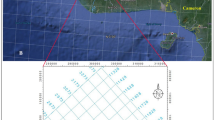In order to study the reasons for borehole instability, we calculated the mud density window for horizontal wells in complex formations based on logging data. From the results of the mud density window calculation, we found that for mudstone shales it decreases as the inclination angle and the azimuth increase, while for coal it took on negative values. We found that collapse and expansion are conducive to maintaining borehole stability, while in coal seams a positive mud density window can be achieved only by collapse (a decrease in the borehole diameter). It was determined that we need to increase the mud density from 1.2 to 1.4 g/cm3 and use drill pipes that are as small as possible for the longest possible period of time. In this case, the borehole trajectory should be determined according to the seam location and the mud density.






Similar content being viewed by others
References
Adel M. Al-Ajmi and Mansoor H. Al-Harthy, “Probabilistic wellbore collapse analysis, Journal of Petroleum Science and Engineering, 74, Nos. 3-4, 171-177 (2010).
R. Braun, “Critical borehole orientations: Rock mechanics aspects,” Oil Gas European Magazine, 36, No. 2, 75-79 (2010).
Xi-sheng Liu, “Analysis of wellbore stability for Niuzhuang zone,” Dissertation, China University of Petroleum, Shan Dong (2006).
A. L. Merlani, E. Salusti, and G. Violini, “Non-linear waves of fluid pressure and contaminant density in swelling shales,” Journal of Petroleum Science and Engineering, 79, Nos. 1-2, 1-9 (2011).
Mohammad Ebrahim Zeynali, “Mechanical and physical-chemical aspects of wellbore stability during drilling operations,” Journal of Petroleum Science and Engineering, 82-83, 120-124 (2012).
Hamid Roshan and S. S. Rahman, “Analysis of pore pressure and stress distribution around a wellbore drilled in chemically active elastoplastic formations,” Rock Mechanics and Rock Engineering, 44, No. 5, 541-552 (2011).
Saeed Salehi, Geir Hareland and Runar Nygaard, “Numerical simulations of wellbore stability in under-balanced-drilling wells,” Journal of Petroleum Science and Engineering, 72, Nos. 3-4, 229-235 (2010).
Jian-fa Ci, “Wellbore stability before drilling,” Dissertation, Southwest Petroleum University, Sichuan (2006).
Author information
Authors and Affiliations
Corresponding author
Additional information
Translated from Khimiya i Tekhnologiya Topliv i Masel, No. 2, pp. 41 – 45, March – April, 2016.
Rights and permissions
About this article
Cite this article
Hao, Y. Borehole Stability in Mudstone Shale and Coal Seams in the Daniudi Gas Field. Chem Technol Fuels Oils 52, 185–193 (2016). https://doi.org/10.1007/s10553-016-0689-y
Published:
Issue Date:
DOI: https://doi.org/10.1007/s10553-016-0689-y




